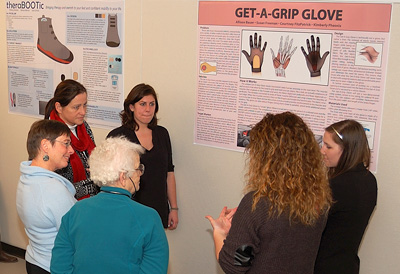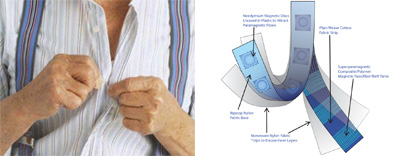Students devise magnetic 'snaps,' nerve-stimulating shoes
By Ted Boscia

Do you suffer from "Kindle-itis" -- arm or wrist pain caused by extended use of electronic readers and other mobile devices? To provide relief, a group of students has conceived of the Swiss Kindle Glove, a sleeve affixed with a detachable and adjustable stand to hold portable gadgets for hours of enjoyment.
The glove project stems from a Cornell Fiber Science & Apparel Design (FSAD) course in which students developed product ideas -- with frequent feedback from local senior citizens -- for functional apparel to help the elderly and other populations more easily go about their daily lives.


The glove, for example, is made from a high-performance fabric that compresses the wearer's muscles and soothes arthritic symptoms by stimulating blood flow through the wrist and hand.
Brittany Lutz '12, Margaret Dimmick '12, Emily Yeh '13 and graduate student Kristen Morris, developed the idea in the course Textiles, Apparel and Innovation, taught by FSAD associate professor Juan Hinestroza in the College of Human Ecology each fall since 2006.
"By talking to the seniors, we learned that because of problems with arthritis and joint tension and stress, reading with Kindles could be really painful," said Lutz, a fashion design management major. "We wanted to design something that would make reading a pleasure, not a problem to be dealt with."
Throughout the course, Hinestroza, a fiber scientist, encouraged his students to remake traditional garments for new purposes by applying nanotechnology to conventional fabrics and products. He also asked them to incorporate sustainability principles to limit costs and environmental impact and to encourage reuse.
The student teams' other high-tech innovations included:
"It is applying cutting-edge nanotechnology," said Sandy Flint, a graduate student in the field of fiber science. "When we were coming up with the specifics for the magnetic strip and fabric, we were working from research that is just coming out of the lab."
The class met with four local seniors Dec. 1 in the Human Ecology Building to present their completed research posters and hear final feedback. Christine Baron, a retired home economics teacher from Cortland, N.Y., and one of the local advisers on the project, visited the class four times during the semester and called the project "a great learning experience."
"When I was doing textiles studies, Velcro was the newest thing on the market," she said. "It was really interesting to hear about all the new technologies that are possible."
Some of the student teams hope to continue to refine their ideas and possibly file for patents.
"The class has been helpful because we've been forced to think about what is practical and marketable if our product ever made it to the market," said Mariana Barreto '13. "Based on the feedback, we had to drop ideas or scale back along the way because we realized it wouldn't work in reality."
Ted Boscia is assistant director of communications for the College of Human Ecology.
Get Cornell news delivered right to your inbox.
Subscribe